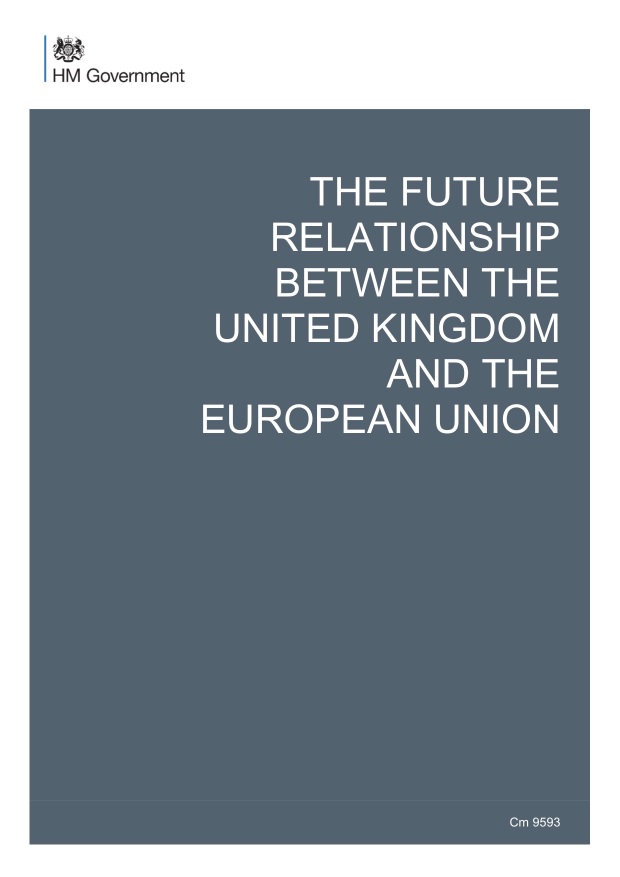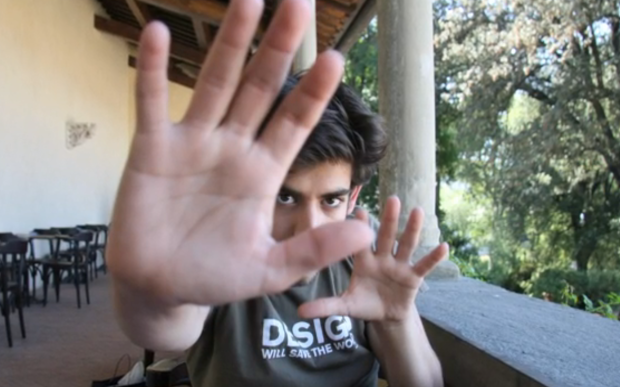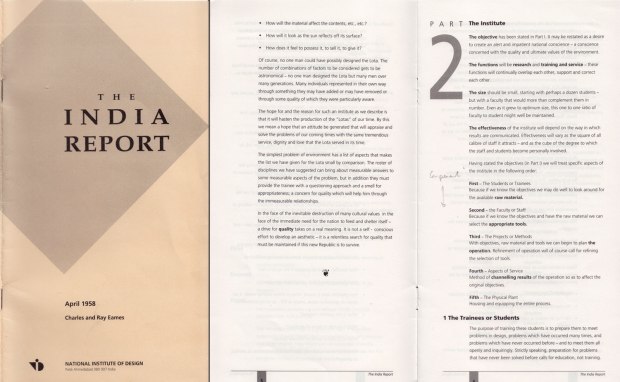The UK Government paper titled: The future relationship between the United Kingdom and the European Union, otherwise known as ‘The Chequers agreement’, after the Buckinghamshire country manor house where the agreement was first made, is as much a work of design as of policy.

The UK Prime Minister, Teresa May, delivers a speech on Brexit to the EU. Photograph: Associated Press
The foreword is by the UK Prime Minister, Teresa May, who begins:
“In the referendum on 23 June 2016 – the largest ever democratic exercise in the United Kingdom – the British people voted to leave the European Union.” [1]
She goes on resolutely:
“And that is what we will do – leaving the Single Market and the Customs Union, ending free movement and the jurisdiction of the European Court of Justice in this country, leaving the Common Agricultural Policy and the Common Fisheries Policy, and ending the days of sending vast sums of money to the EU every year. We will take back control of our money, laws, and borders. And…”
And after ripping it all up:
“… begin a new exciting chapter in our nation’s history.”
Who is the author of that chapter?
Teresa goes on:
“It now falls to us all to write that chapter.”
Ah! This must be a huge exercise in democratic and participative design, where we can all pitch in our ideas and a solution seamlessly emerges, as if shaped by an invisible hand.
Well, not quite. The ‘us’, of course, is really ‘not us’. The authors of the chapter will be the lawmakers: politicians and others who will codify our future. The ‘us’ may get to say yes or no, but this isn’t an exercise in participative design.
The Chequers agreement is a 98 page document, presented in 4 chapters, laying out (in order) the economics, security, cooperation, and institutions of Brexit. The document mentions the word design (or its variants) thirteen times, but they are significant mentions about significant things.
Designing, in Brexit terms, means designing new relationships and partnerships, new proposals, new arrangements, new institutional arrangements, new rules, new policies and policy tools, new systems, and new committees.
That is an awful lot of ‘new’, and an awful lot of designing. What kind of designing is it exactly though? and who will do it? Or more pertinently, does the ‘not us’ have the necessary experience to come up with good designs? (And how will we know they are good designs?)
Taking out each mention of design in the Chequers agreement, and turning it around, makes Brexit read like the curriculum for a new kind of design school [2]:
Design an institutional framework that facilitates dialogue [i]
Design a new trading relationship that ensures frictionless access to each other’s goods [ii]
Design a proposal based on principles of reciprocal commitments [iii]
Design a facilitated customs arrangement [iv]
Design a common rulebook [v]
Design an agricultural policy that delivers market relevant outcomes [vi]
Design a migration system that works for all parts of the UK [vii]
Design a system to promote domestic production and preserve cultural identity [viii]
Design ‘horizontal’ rules that ensure open and fair markets [ix]
Design a global rule for new and disruptive technologies [x]
Design a partnership that makes tracking crime across borders efficient and reliable [xi]
Design an effective sanction [xii]
Design a Joint Committee to prevent disputes arising [xiii]
Or perhaps this a very old kind of design school, because agriculture, trade, and disruptive technologies have been around for at least 5000 years.
The problems above are reducible to designing two other kinds of thing that are mentioned in the Chequers agreement: systems (62 mentions), and rules (110 mentions).
But perhaps most of all Brexit will be about designing systems of rules.
The design of these rule-based systems will take imagination, to think out the particularities and the consequences that might develop. So does the ‘not us’ include people with this kind of imagination? People that can exercise a sophisticated design intelligence in meeting practical, political, ethical, and aesthetic [3] constraints?
I’m not sure that the UK has these kinds of people, or at least doesn’t provide systematic (that word again) ways of training and educating them. We are good at producing political analysts, policy advisors, economists, journalists and philosophers. And they are all good at talking a good game.
But changing the rules of the game requires systematic imagination and creative integrity that should be open to question. It shouldn’t be ‘ta da – here’s a solution’, it should be ‘here is the design process we went through to arrive at this proposal’. The people are not trained in how to make design decisions and consider the possible consequences of those decisions (though they may consider consequences from previous decisions of others). Rather than learning from failure during their education, they learn by very real failure in practice [4].
Perhaps the design of Brexit needs first to include the design of curriculum that can deliver this kind of knowledge and develop the missing designers of today. Game Design 101 might not be a bad place to start.
Notes
[1] To be precise 17.4 million people voted to leave, out of an estimated population of 65.6 million (and a population of those eligible to vote of 46.5 million – 19.1 million people being under the voting age of 18).
[2] Actually not unlike the one proposed by Charles and Ray Eames’ India Report that I described in a previous post looking at design education.
[3] The word ‘frictionless’ (11 mentions in the Chequers agreement), for example, suggests something aesthetic. What do you think of when you think of something frictionless? I think of air hockey. It also suggests that clever interaction and service design will be necessary.
[4] Indeed Article 50 of the 2009 Lisbon Treaty, consisting of five paragraphs, and formulated to allow any member state to withdraw from the EU, could well be an example of this failure. In this case the rule designer was John Kerr, a Scottish Member of the UK Parliament.
Design references to the UK Government’s document on Brexit
[i] “The institutional framework should prevent disputes arising but in the unlikely event that they did, it should be designed in a way that facilitates dialogue.” (page 92)
[ii] “In designing the new trading relationship, the UK and the EU should therefore focus on ensuring continued frictionless access at the border to each other’s markets for goods.” (page 7)
[iii] “These principles, together with strong reciprocal commitments on open and fair trade, and propositions for a new institutional framework, inform the design of the UK’s proposal.” (page13)
[iv] “The Facilitated Customs Arrangement is designed to ensure that the repayment mechanism is only needed in a limited proportion of UK trade, and to make it as simple as possible to use for those who need to use it.” (page 18)
[v] “The UK would also seek participation – as an active participant, albeit without voting rights – in EU technical committees that have a role in designing and implementing rules that form part of the common rulebook.” (page 20)
[vi] “The UK will be free to design agricultural support policies that deliver the outcomes most relevant to its market, within the confines of WTO rules.” (page 24)
[vii] “The UK will design a system that works for all parts of the UK. The Migration Advisory Committee (MAC) report, due in September 2018, will provide important evidence on patterns of EU migration and the role of migration in the wider economy to inform this.” (page 32)
[viii] “European Works is a system designed to promote domestic European production and preserve cultural identity.” (page 37)
[ix] “Some horizontal rules are not primarily designed to ensure open and fair markets. Nonetheless, it is usual to include commitments on these areas in Free Trade Agreements (FTAs).” (page 37)
[x] “The UK will be agile enough to provide thought leadership on the shape and design of new global rules for new and disruptive technologies.” (page 50)
[xi] “As the UK and the EU design a new partnership, maintaining efficient and reliable operational capabilities will be vital, including but not limited to:
- a. the efficient extradition of criminals and wanted individuals between Member States and the UK;
- b. cooperation of judicial, police and customs authorities in different states; and
- c. delivering cross-border criminal investigations and prosecutions.”
(page 59)
[xii] “Sanctions are a key foreign policy tool and are most effective when designed and applied alongside international partners.” (page 65)
[xiii] “Through regular and structured dialogue, the Joint Committee would be designed to prevent disputes from arising, whether related to implementation, enforcement or compliance.” (page 88)








